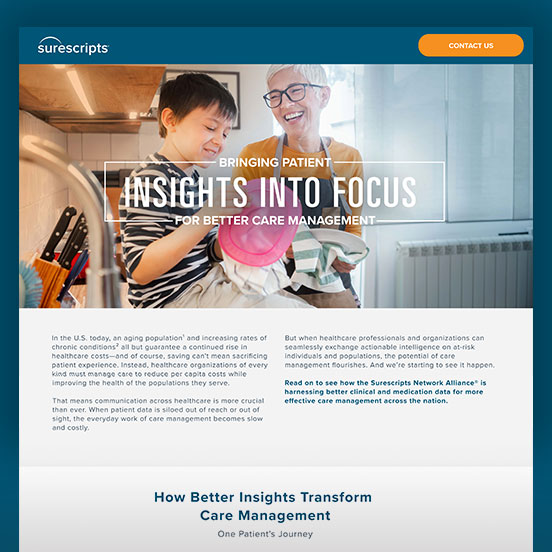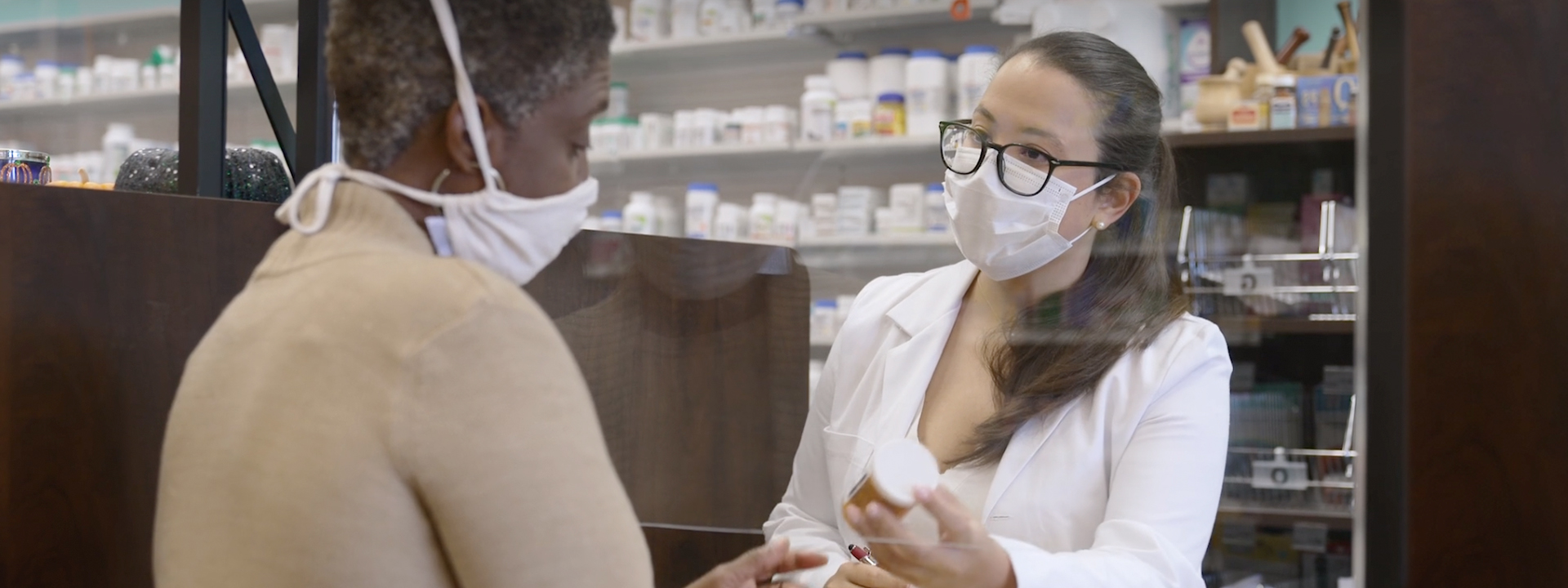Robert Dean leaned back in his chair and took a moment to think. “For me, knowing that we’re doing the right thing for our patients at the right time, and that we’re getting them into a better place in terms of health and quality of life,” said Dean, “Well, I just love being part of that process and part of an organization that prioritizes that.”
That organization is New York City’s Mount Sinai Health System, where Dean works as a care navigator, helping patients with chronic conditions manage their health, including remaining adherent to their medications.
Mount Sinai, like any other major metropolitan health system, is focused on value-based care and population health. The health system covers three boroughs with 13 hospitals and includes more than 7,000 physicians across more than 400 community locations.
“Our goals are to improve medication adherence and related patient outcomes as well as reduce readmissions and unnecessary medication spend on the part of plans and patients,” said Ruchi Tiwari, Pharm.D., M.S., and Mount Sinai’s executive director of ambulatory pharmacy and population health.
Dean is on a team with six other care navigators under Tiwari’s umbrella, who, in total, look after 10,000 patients with diabetes, hypertension and high cholesterol. They deliver high touch care, calling and checking in on patients about their medications and often bridging the gap between them, their doctors and their pharmacists. Building trust is critical.
“We Always Need to Appreciate They’re Being Vulnerable with Us”
Care navigator Karintha Green said patients sometimes aren’t always receptive to a call out of the blue, but once she identifies who she is and where she’s calling from, “a little light bulb goes off, ‘Oh, they really want to help me. Well, let me tell you this.’ And you’ll be surprised the flood gate that opens. For me, that’s the reward. I love it.”
“Economic stability is always something we’re cognizant of, and it’s something that patients are embarrassed to talk about. We always need to appreciate the fact that they’re being vulnerable with us,” added Tasnima Nabi, Pharm.D., clinical pharmacy manager at Mount Sinai Health Partners. Nabi supports Tiwari and works closely with the care navigator team. “Sometimes patients will tell you they can’t afford their medications. So, we’ll discuss formulary alternatives with their providers or talk with patients about secondary insurances they can apply for.”
“The population of patients that we speak to—a lot of them are vulnerable, they’re elderly. Many even forget when they’re supposed to be taking their medications or picking them up,” said fellow care navigator Rosemary Acosta. “So, for us to call these patients, and they’re like, ‘Oh wow. Someone actually cares to reach out to me, to remind me to take my medications, to ask if I have any barriers or issues in taking them’…that appreciation that they show really makes the job worth it…and we get to see these amazing patient outcomes.
“We get to see these amazing patient outcomes”
Care Navigator Rosemary Acosta
“A little light bulb goes off: “Oh they really want to help me.” For me, that’s the reward”
Care Navigator Karintha Green
“Getting these Surescripts notifications allows us to know the right time to contact these patients and engage them”
Care Navigator Robert Dean
“If Our Beds Are Filled It Means We’ve Failed”
A few years ago, the chief executive officer of Mount Sinai Health System, Kenneth L. Davis, M.D, famously said, “If our beds are filled, it means we’ve failed. The system is still going to deliver exceptional care to those who need complex care. But we're looking at it and saying if we do our job up front in preventive care, there shouldn't be that many people in the hospital.”
Mount Sinai has long been on the vanguard in embracing innovation and new technologies to meet that mission—keeping their beds far from filled and their patients healthy. But as one can imagine, providing high touch care for 10,000 patients carries a heavy administrative load. And the population health team at Mount Sinai was managing it with spreadsheets and calendar notifications.
Tiwari recalled how she and her colleague Adam Brown, who is director of population health and payer systems IT, brainstormed how to use technology to improve their rather retroactive process, which was informed by claims data that was often months old.
“How do we get data that will inform us on when we should trigger an outreach to a patient when an event has happened? We don’t want to call patients and say, ‘Hello, it looks like you missed your med,’ and have them reply, ‘I’m in a long-term care facility for three months. Why don’t you know this?” said Tiwari. “We didn’t have a lot of good data that helped us to understand when’s the right time to reach out to a patient.”
Brown and Tiwari ultimately landed on partnering with Surescripts to address the challenge, piloting Medication History for Populations, which included a new feature—patient notifications—in April 2019.
The technology proactively informs care teams in near real time when refills aren’t picked up, when there are no refills remaining, and when there are prescriptions from new providers, among other notifications, which the care navigators receive in their workflow. Care teams can anticipate non-adherence or adverse drug events—and reach out to their patients before it happens. After just five months, the team was already seeing promising results. Their percentage days calculated (PDC) rate, which indicates how long a patient has been adherent to their medication, had gone up nearly 60%.
Impact Report
Bringing Patient Insights into Focus
When healthcare professionals can seamlessly exchange clinical and medication data on at-risk populations and individuals, care management flourishes.
“It’s Remarkable What We’ve Been Able to Uncover”
Before the care team was able to leverage Medication History for Populations Patient Notifications, they had to manually track and mine the data on 10,000 patients themselves.
“We were essentially keeping a calendar schedule of at-risk patients in our program…to keep track of who needs to be called every 30 days for a reminder call,” said Tiwari. “That’s very hard for us to do well and reliably.”
“We had one massive spreadsheet with all payers, all practices, all medications for all of our patients,” added Nabi. “I would download the data set every Wednesday from our shared drive and it would take forever to load.”
Once the spreadsheet opened, Nabi explained that she would try to prioritize patient outreach by looking at patient names and at their corresponding PDCs. If their PDCs were failing or at risk of failing, she would then direct the team to narrow in on those patients.
“Having these notifications pushed to us that are reliable, gosh, it’s just amazing,” Tiwari added. “Then we don't have to have navigation staff sitting with Excel and these different tool sets that are not convenient, time-sensitive or making the best use of their skill sets. It is a lot more efficient.”
Nabi agreed. “Working with Surescripts and having that actionable, time-sensitive data, we’re now able to make our outreaches in a more time-sensitive manner,” she said, adding that it truly helps her team determine the right interventions at the right time.
“Having these notifications pushed to us that are reliable, gosh, it’s just amazing”
Ruchi Tiwari, Mount Sinai’s executive director of ambulatory pharmacy and population health
The Medication History for Populations patient notifications come directly into the care teams’ electronic medical record (EMR) system. The care navigators are no longer “guesstimating”; they have timely data in their hands that indicates whether an intervention is warranted. Missed or no-refills left alerts come in daily, with such specificity as: patient picked up today, but they have no refills remaining.
“It’s remarkable what we’ve been able to uncover,” said Tiwari. “We’ve uncovered polypharmacy, duplications in therapy and general medication confusion in patients before they become at risk of failing the measure. Then we added a new layer of how to prioritize patients. So now, we can take all of this great data and create different priority levels based on just their historical behaviors. All of this was completely missing from our workflow before.”
The care navigators often talk to their patients’ providers daily, frequently serving as a bridge between patient and provider and clinical pharmacist to ensure correct prescriptions, timely refills or to schedule appointments.
“Getting these Surescripts notifications allows us to know the right time to contact these patients and help facilitate their education and engagement with their providers,” said Dean. “And so, every day we're distributing and reviewing these medication alerts, we're checking our lists to see who's the highest priority for outreach. And we also have the chance to canvas the chart to see what’s happening with a patient. Do they have an upcoming appointment? Have they not been seen in six months or a year by their primary care physician? And we’re able to facilitate that engagement.”
The New Tool Has Prevented Real Patient Harm
Medication History for Populations patient notifications have also helped the team uncover care events that could have led to real patient harm. Dean recalled following up with a patient who hadn’t picked up their medication after receiving a notification.
“In talking with the patient, I learned that they’d been admitted [to the hospital] in May because they had contracted the coronavirus,” Dean said. “Upon admittance, the nephrologist had taken the patient off their hypertension medication. In looking at the patient’s chart I noticed they didn’t have a follow up appointment with their primary care physician…and that their medication list reconciled with their discharge medication list [indicated] that the patient hadn’t resumed taking their hypertension medication after discharge.”
Dean immediately connected the patient with their primary care physician and the patient was able to resume taking the medication.
Acosta also talked about making an intervention just in time. “I had a patient who didn’t realize they were due for their medication refill—an elderly patient,” she shared. “That real-time notification told me that the patient was due for her medication the very next day. I called the patient to make sure she was aware—and she wasn’t. So, I messaged her provider to send refills not only on that particular medication but her whole blister pack. I was able to ensure that the delivery of that medication would get to her just in time.”
Near the end of our conversation, Tiwari took a moment to reflect on her philosophy—as well as her terrific team.
“We need to seize the moments in a patient's journey that really matter where they’re like, ‘I'm paying attention to my health care right now.’ These moments are only going to be there for maybe an hour a week. They've got other things to worry about. My philosophy is let's turn that opportunity into a delightful moment and solve their medication concerns, and then also close quality gaps, notify their providers of our findings and reconnect patients with our health-system,” said Tiwari. “We’ve got these really amazing folks—our care coordinators—who just know how to talk and connect with people. It requires a different skillset from clinicians,” she added. “But this outreach…it would be hard for us to develop a confident team to provide this high level of service if we didn’t trust the data.”
Let us help you unlock access to critical clinical and medication data that help address costly—but common—gaps in care and coordinate successful care transitions. Check out the report Bringing Patient Insights into Focus for Better Care Management.


 Dean Riggott Photography
Surescripts
Dean Riggott Photography
Surescripts






